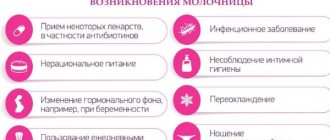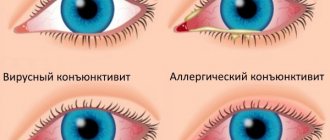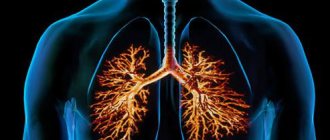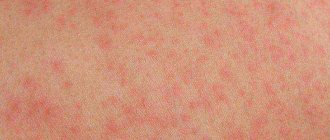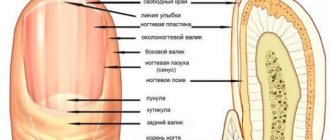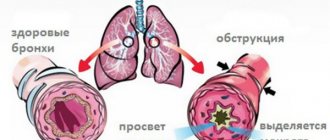Bronchitis is an inflammatory disease that develops as a result of bacterial, viral, fungal and other infections in the bronchial tree and is accompanied by general intoxication of the body, cough with sputum and in some particularly severe cases, shortness of breath.
Bronchial asthma is a chronic disease of the bronchopulmonary system, which is characterized by the presence of reversible attacks of broncho-obstruction (narrowing of the bronchi) that occur in predisposed patients and are associated with the action of provoking factors.
These factors include:
- hereditary predisposition;
- physical exercise;
- frequent use of aspirin in sensitized patients;
- allergic reactions associated with the entry of allergens into the bronchi during breathing, this can be pollen, house dust, chemicals, etc.
Bronchial asthma is characterized by paroxysmal course.
The severity of the attack is determined by a special classification: 1st degree – intermittent bronchial asthma:
Attacks of reversible bronchial obstruction occur rarely, about once a week, exacerbations are short-lived, and usually do not disrupt the usual daily routine (sleep, work, physical activity). Symptoms (shortness of breath, sputum, cough, wheezing) are short-lived. Nocturnal asthma attacks do not bother me. FEV1 (forced expiratory volume in 1 second) when performing spirometry (a method of measuring the speed of air flow that enters and exits the lungs) is 80% of normal.
Stage 2 – persistent bronchial asthma of mild severity:
Attacks of bronchial asthma occur once a week, but less than once a day; exacerbations of the disease are short-lived, but affect work activity, appetite and sleep. Such patients require sick leave for 3–7 days. Symptoms of the disease (cough, sputum, wheezing) persist for 24 hours after an attack. Nocturnal bronchial obstruction occurs about 2 times a month. FEV1 – 80% of normal.
Stage 3 – persistent bronchial asthma of moderate severity:
Attacks of reversible bronchial obstruction occur almost every day, exacerbations of the disease are prolonged and sharply disrupt work activity and daily routine. Such patients require sick leave with a duration of at least 10–15 days. Symptoms of bronchial asthma (cough, sputum, wheezing, shortness of breath, etc.) persist for a week. Night attacks occur more than once a week. FEV1 – 60 – 80% of normal.
Stage 4 – persistent bronchial asthma of severe severity:
Attacks of bronchial obstruction are daily, exacerbations of the disease are long-lasting, symptoms (cough, wheezing, sputum, etc.) are constantly present. Such patients require constant care. Night attacks occur 2-3 times a week. FEV1 – 60% of normal.
Reasons for the development of the disease
The disease occurs under the influence of various factors.
It can be caused by both non-infectious allergens and pathogenic microorganisms that enter the body through the respiratory system or digestive tract. Allergens
- pollen;
- food components;
- household dust;
- animal hair;
- substances included in medications or vaccines.
Patients often exhibit increased sensitivity to several types of allergens. The hereditary nature of allergies is often discovered.
The cause of asthmatic inflammation of the bronchi of infectious origin is most often staphylococcus. This disease can also develop as a result of previous influenza, whooping cough, inflammatory and infectious processes in the respiratory tract, and acute respiratory infections.
The causes of asthmatic bronchitis are diverse; the disease can be provoked by both infectious agents and non-infectious allergens. Infection with viruses, bacteria and fungi can be considered as infectious factors, and various allergens to which a particular person is sensitive can be considered as non-infectious.
There are two large groups of causes of asthmatic bronchitis:
- Infectious etiology of the disease:
- Most often, the cause of the development of bronchial pathology in this case is staphylococcus. Similar conclusions could be drawn based on the frequency of its inoculation from secretions secreted by the trachea and bronchi.
- The disease may develop against the background of a respiratory viral infection, as a result of influenza, measles, whooping cough, pneumonia, after tracheitis, bronchitis or laryngitis.
- Another reason for the development of asthmatic bronchitis is the presence of a disease such as GERD.
- Non-infectious etiology of the disease:
- The most common allergens that irritate the walls of the bronchi are house dust, street pollen, and inhalation of animal hair.
- The disease may develop when eating foods containing preservatives or other potentially dangerous allergens.
- In childhood, bronchitis of an asthmatic nature can develop due to vaccination if the child has an allergic reaction to it.
- There is a possibility of manifestation of the disease due to taking medications.
- The factor of heredity should not be excluded, since it can often be traced in the anamnesis of such patients.
- Polyvalent sensitization is another risk factor for the development of the disease, when a person has increased sensitivity to several allergens.
As doctors observing patients with asthmatic bronchitis note, exacerbations of the disease occur both during the flowering season of many plants, namely in spring and summer, and in winter. The frequency of exacerbations of the disease directly depends on the cause that contributes to the development of the pathology, that is, on the leading allergic component.
Asthmatic bronchitis has a polyetiological nature. In this case, direct allergens can be both non-infectious agents and infectious factors (viral, fungal, bacterial) entering the body aerobronchogenically or through the gastrointestinal tract. Among non-infectious allergens, house dust, fluff, plant pollen, animal hair, food components and preservatives are most often detected. Asthmatic bronchitis in children can be a consequence of drug and vaccine allergies. Polyvalent sensitization often occurs. Often in the patient's medical history there are indications of a hereditary predisposition to allergies (exudative diathesis, neurodermatitis, allergic rhinitis, etc.).
In most cases, the infectious substrate of asthmatic bronchitis is pathogenic staphylococcus. This is indicated by the frequent inoculation of the microorganism from the secretions of the trachea and bronchi, as well as the increased level of specific antibodies in the blood of patients with asthmatic bronchitis. Often, asthmatic bronchitis develops after suffering from influenza, ARVI, pneumonia, whooping cough, or measles. There have been repeated cases of the development of asthmatic bronchitis in patients with gastroesophageal reflux disease. Depending on the leading allergic component, exacerbations of asthmatic bronchitis may occur in the spring-summer period (plant flowering season) or the cold season.
Most often, allergic bronchitis is provoked by various allergens, as well as fungal, viral and bacterial infections that penetrate the respiratory system and gastrointestinal tract.
- In bronchial asthma in children, symptoms may be a consequence of a negative reaction to vaccination;
- asthma can occur due to dust mites, pollen, animal waste products, food and various chemical components;
- Genetic predisposition to the development of allergic diseases is of no small importance;
- In addition, asthmatic diseases can be caused by staphylococci, which, as a rule, populate the trachea and bronchi. Very often, asthmatic bronchitis can appear due to viral infections. In this case, a specific antibiotic must be prescribed.
The peak of the disease occurs in spring and summer, when there is abundant flowering and the patient comes into contact with plant pollen.
As noted earlier, bronchitis with an asthmatic component has a polyetiological nature, that is, it can arise as a result of the influence of several factors.
The sooner the doctor finds out what caused the pathology to appear, the more effective the treatment will be. Determining the root cause is an important step.
In atopic bronchitis, the disease is a consequence of the development of an allergic reaction to a non-infectious irritant. Most often, such an irritant is house dust, animal hair, plant pollen or poplar fluff.
There are often cases when household chemical vapors, some product or food additive become an allergen. In children, allergies can be caused by medications or vaccines if there is an individual intolerance.
In all of the above situations, the patient's exposure to the allergen should be limited as soon as possible. It is likely that the disease will disappear on its own.
The cause of the development of the disease in infectious bronchitis is the influence of viruses, bacteria and even fungi on the body. In most cases, this form of bronchitis occurs due to infection with pathogenic staphylococcus.
The presence of infection can be determined by analyzing the secretions of the bronchial tree or by an increased level of specific antibodies.
There are often cases when a harmless viral or bacterial disease is complicated by asthmatic bronchitis. As a rule, complications are caused by influenza, ARVI, ordinary bronchitis or tracheitis, and lung diseases.
At risk are children under two years of age who have measles or whooping cough. In a small child, if he is sick, the reaction of the bronchi to extraneous stimuli is exacerbated.
General information
- Shortness of breath during exhalation
- An obsessive cough that gets worse at night
- Enlarged veins in the neck area
- Blue skin
- The need to breathe with the help of additional muscles
- Inhalation is accompanied by flaring of the nostrils
- Symptoms intensify after physical activity, stress, illnesses associated with the respiratory system and interaction with allergens
If there are characteristic symptoms, the help of your attending physician is necessary so that he can distinguish bronchitis from asthma and prescribe treatment.
Asthmatic bronchitis is an infectious-allergic disease of the lower respiratory tract, characterized by hypersecretion of the mucous membrane, swelling of the walls, spasm of the large and middle bronchi. With asthmatic bronchitis, unlike bronchial asthma, attacks of severe suffocation usually do not occur. However, in modern pulmonology, asthmatic bronchitis is regarded as a condition of pre-asthma.
Asthmatic bronchitis
Diagnostics
At the first symptoms, you should immediately contact a competent medical professional. During a personal examination, the doctor must pay attention to the patient’s personal and family history. Diagnostics are also carried out using the following laboratory and instrumental tests:
- general and biochemical blood tests;
- sputum collection for bacterial culture;
- blood testing for the presence of allergens;
- X-rays of light.
If the diagnosis of asthmatic bronchitis is confirmed, treatment should begin immediately.
Symptoms of asthmatic bronchitis
Typically, the course of bronchitis with an asthmatic component is recurrent: the patient experiences periods of exacerbations and remissions. However, during remission, the symptoms completely disappear, and it may seem that the disease has passed.
But they return during the next phase, and such relapses, if they happen more than once or twice, ultimately lead to the development of bronchial asthma.
The symptoms of asthmatic bronchitis depend to some extent on what form of bronchitis the patient has, but are generally similar. The acute variety is characterized by:
- a sharp dry cough (during remission - wet), which occurs in the patient paroxysmally after physical activity;
- noisy difficulty breathing with whistling and wheezing, shortness of breath, but without the development of status asthmaticus;
- slight malaise, weakness;
- low-grade fever (from 37.1 to 38.0 °C) and sweating;
- sore and itchy throat;
- nasal congestion due to swelling of the nasal sinuses;
- chest pain in the area of the bronchial tree;
- irritability.
If bronchitis has entered the chronic stage, then some symptoms weaken and do not give an accurate picture, although they still greatly bother the patient.
Despite the fact that there is generally no temperature and signs of intoxication, the patient constantly coughs, especially at night, and shortness of breath is also observed.
If the disease is accompanied by bronchial obstruction, noticeable attacks of suffocation are not observed, since the bronchioles are not affected. The respiratory organs do not change, so an x-ray will not be able to show the presence of the disease.
However, secretions, often purulent, will still collect in the bronchi, and a significant risk of complications remains.
The course of asthmatic bronchitis is recurrent in nature with periods of exacerbation and remission. In the acute phase, coughing attacks occur, which are often provoked by physical activity, laughter, and crying. Cough paroxysms may be preceded by precursors in the form of sudden nasal congestion, serous-mucous rhinitis, sore throat, and mild malaise. During an exacerbation, body temperature can be low-grade or normal. At first, the cough is usually dry, but later during the day it can change from dry to wet. An acute cough attack in asthmatic bronchitis is accompanied by difficulty breathing, expiratory shortness of breath, noisy, forced wheezing exhalation. Status asthmaticus does not develop. At the end of the paroxysm, there is usually a discharge of sputum, followed by an improvement in the condition.
A feature of asthmatic bronchitis is the persistent repetition of symptoms. At the same time, in the case of the non-infectious nature of the disease, the so-called elimination effect is noted: coughing attacks stop outside the action of the allergen (for example, when children live outside the home, changes in diet, changing seasons, etc.). The duration of the acute period of asthmatic bronchitis can range from several hours to 3-4 weeks. Frequent and persistent exacerbations of asthmatic bronchitis can lead to the development of bronchial asthma.
Most children suffering from asthmatic bronchitis have other allergic diseases - hay fever, allergic skin diathesis, neurodermatitis. Multiorgan changes do not develop in asthmatic bronchitis, but neurological and autonomic changes can be detected - irritability, lethargy, increased sweating.
The first sign of asthmatic bronchitis is a severe, dry cough.
The disease with an asthmatic component occurs with alternating periods of relapses and remissions. The exacerbation lasts from 3-4 hours to 3-4 weeks. It usually begins with attacks of a painful dry cough, which is preceded by a sore throat, nasal congestion and runny nose, and general malaise. In some cases, there is an increase in temperature to subfebrile levels. After about a day, the cough becomes productive and sputum begins to form.
With a cough paroxysm, the patient has significant difficulty breathing when exhaling. It is as if he is not exhaling, but pushing the air out of himself, using the abdominal muscles. With a cough, sputum is released, and after the attack there is relief. Unlike asthmatics, patients with asthmatic inflammation of the bronchi do not develop a severe, life-threatening condition called status asthmaticus (swelling and obstruction of the bronchioles, leading to suffocation and oxygen deprivation).
Such signs are typical for patients of any age: there is no difference in symptoms in adults and children.
In children who are diagnosed with asthmatic bronchitis, in the vast majority of cases other allergic diseases are also observed: seasonal hay fever, diathesis, neurodermatitis.
A distinctive feature of this type of bronchitis is the stubborn persistence of symptoms, subject to exposure to a provoking factor. If the allergen is eliminated, the attacks stop.
Characteristic manifestations of the disease are:
- with this disease, symptoms manifest themselves in the form of coughing attacks, which bother the patient as a result of physical exertion, crying or emotional stress. At the very beginning of asthma, the cough is dry, but as symptoms increase, a small amount of sputum appears;
- There is severe rhinitis, sore throat and weakness. In this case, it is recommended to carry out inhalations with medications. When a bacterial or viral infection occurs, it is necessary to use an antibiotic and immunomodulators;
- the temperature during bronchitis with asthmatic syndrome can rise to low-grade levels (38°C);
- An acute attack of asthma is accompanied by difficulty breathing, which develops severe shortness of breath and wheezing when exhaling. When using inhalation, copious discharge of sputum is noted and a general improvement in the patient's condition occurs;
- symptoms can systematically recur with the non-infectious development of bronchial asthma. In this case, it is necessary to stop contact with the immediate allergen. If asthma attacks are not treated promptly, the acute period can last for 1 month;
- in some cases, neurological disorders are possible, when there is increased fatigue, lethargy, irritability and increased sweating.
It should be noted that asthmatic bronchitis in childhood may be accompanied by urticaria, neurodermatitis and other characteristic reactions. As a rule, other changes in bronchitis of an asthmatic nature are not observed at this age.
The disease is prone to frequent relapses, with periods of calm and exacerbation.
Symptoms of asthmatic bronchitis are:
- Paroxysmal cough. They tend to intensify after physical activity, while laughing or crying.
- Often, before the patient begins another coughing attack, he experiences sudden nasal congestion, which may be accompanied by rhinitis, sore throat, and mild malaise.
- During an exacerbation of the disease, body temperature may rise to subfebrile levels. Although often it remains normal.
- A day later from the beginning of the acute period, a dry cough transforms into a wet one.
- Difficulty breathing, expiratory shortness of breath, noisy inhalation with a whistle - all these symptoms accompany an acute attack of coughing. At the end of the attack, sputum is separated, after which the patient’s condition stabilizes.
- Symptoms of asthmatic bronchitis persistently recur.
- If the disease is provoked by allergic agents, then coughing attacks stop after the effect of the allergen ceases.
- The acute period of asthmatic bronchitis can last from several hours to several weeks.
- The disease may be accompanied by lethargy, irritability and increased activity of the sweat glands.
- Often the disease occurs against the background of other pathologies, such as allergic neurodermatitis, hay fever, diathesis.
The more often a patient experiences exacerbations of asthmatic bronchitis, the higher the risk of developing bronchial asthma in the future.
Treatment of asthmatic bronchitis
When treating pathologies, doctors focus their efforts on eliminating the causes and their occurrence. Treatment is carried out using antibacterial and antiviral agents. In asthma, it is important to eliminate interactions with irritants. If contact with the allergen is not eliminated, the attack will recur as soon as the medicine stops working.
Other measures reduce symptoms. Bronchitis is treated with mucolytic agents that thin and remove mucus. The temperature is relieved with antipyretic drugs. In case of obstructive form, medications are taken that dilate the bronchi.
An asthma attack and its symptoms are caused by bronchial spasm. The basis of treatment is bronchodilators - drugs that dilate the bronchi. They relieve bronchospasm, cough and difficulty breathing. Anti-inflammatory drugs are used to reduce symptoms and the risk of attacks.
Much attention is paid to strengthening the immune system. With the help of immunomodulatory agents and vitamin complexes, the sensitivity of the bronchi decreases and the reaction weakens. Proper nutrition, moderate physical activity are required, and allergic reactions are relieved with antihistamines. Treatment is selected individually, based on the characteristics of the patient’s body; self-medication is prohibited, and you cannot take medications not prescribed by your doctor.
Chronic asthmatic bronchitis involves treatment using pharmaceutical drugs that alleviate the patient's condition. Below are the groups of medications that your doctor may prescribe.
Antihistamines
These drugs block the excessive production of histamine in the blood, which means that the effects that histamine entails – allergic reactions – are reduced.
Patients with asthmatic bronchitis may be prescribed Suprastin, Diazolin, Tavegil, Ketotifen, etc.
Antibiotics
If chronic asthmatic bronchitis has worsened due to a bacterial infection, then the patient can be cured with antibiotics. Amoxicillin, Azitrocin, Cefixime, etc. are often prescribed.
Bronchodilators
During the period of exacerbation, chronic asthmatic bronchitis is characterized by coughing attacks. These attacks cause difficulty breathing, accompanied by wheezing and whistling.
To quickly block coughing attacks, topical inhalers that expand the lumen of the bronchi can be used: Salbutamol, Berdual, Fenoterol, etc.
Cough remedies
The cough in asthmatic bronchitis is initially dry, with difficult expectoration. To alleviate this symptom, the doctor prescribes drugs that thin sputum and help remove it from the bronchi: Mucoltin, Ambroxol, Gerbion, etc.
Treating chronic bronchitis, especially with an asthmatic component, is not easy. Treatment must be supervised by a specialist, as he develops an individual course for each patient and adjusts it if necessary.
Which doctor will prescribe treatment depends on the nature of the disease. Atopic bronchitis is dealt with by an allergist, while infectious bronchitis is dealt with by a pulmonologist or therapist.
Eliminating the cause of the disease is half the success, especially when it comes to atopic bronchitis. But in some cases it is impossible to completely prevent the patient from coming into contact with the allergen.
Then specific or nonspecific hyposensitization is used - a set of measures aimed at reducing a person’s sensitivity to the allergen.
During specific hyposensitization, the patient is given injections of the causative allergen, starting with microdoses and gradually increasing the dosage until the body becomes more resistant to external influences.
The immunization course does not end there, but continues for at least another two years to consolidate the results obtained.
Nonspecific hyposensitization is expressed in physiotherapeutic procedures, as well as in taking histaglobulin, allergoglobulin and adaptogens.
For the treatment of chronic asthmatic bronchitis of the allergic type, antihistamines must be prescribed.
The least toxic drugs of the third generation are recommended, where the active ingredients are chloropyramine, clemastine, fexofenadine and others.
Antibiotics are prescribed if bronchitis is infectious in nature, and often they belong to one of the following groups: cephalosporins, lincosamides and macrolides.
The first group has the widest range of effects of all, but antibiotics of the third group not only suppress the activity of harmful viruses or bacteria, but also improve the condition of the bronchial mucosa.
A mandatory part of therapy is taking bronchospasmolytics (bronchodilators) and mucolytics.
The former relax muscle tissue and prevent the occurrence of spasms, the latter help facilitate the separation of sputum by diluting it, and have a weak anti-inflammatory effect.
To generally strengthen the body, the therapist may prescribe inhalations, massage, acupuncture and even light exercise.
To enhance the effect of medications, you can also use traditional medicine methods: herbal infusions, mustard baths, clay applications, and so on.
At the same time, we should not forget that not a single folk remedy can fully replace medications (although some herbs are simply irreplaceable for bronchitis, for example, oregano).
The approach to the treatment of asthmatic bronchitis should be comprehensive and individualized. Long-term specific hyposensitization with an allergen in appropriate dilutions is effective. Therapeutic microdoses of the allergen are increased with each injection until the maximum tolerated dose is reached, then they switch to treatment with maintenance dosages, which is continued for at least 2 years. As a rule, in children with asthmatic bronchitis who received specific hyposensitization, there is no transformation of bronchitis into bronchial asthma.
When carrying out nonspecific desensitization, injections of histaglobulin are used. Patients with asthmatic bronchitis are advised to take antihistamines (ketotifen, chloropyramine, diphenhydramine, clemastine, mebhydrolin). If there are signs of bronchial infection, antibiotics are prescribed. Complex therapy for asthmatic bronchitis includes bronchodilators, antispasmodics, mucolytics, and vitamins. To relieve a coughing attack, inhalers can be used - salbutamol, fenoterol hydrobromide, etc.
Nebulizer therapy, sodium chloride and alkaline inhalations are effective, improving the trophism of the mucous membrane, reducing the viscosity of mucus, restoring the local ionic balance. Physiotherapeutic procedures for asthmatic bronchitis include medicinal electrophoresis, ultraviolet irradiation, general massage, local chest massage, and percussion massage. It is advisable to carry out hydrotherapy, therapeutic swimming, exercise therapy, acupuncture, and electroacupuncture. During periods of remission of asthmatic bronchitis, treatment at specialized resorts is recommended.
Treatment of asthmatic bronchitis requires an individual approach to each patient.
Therapy should be complex and long-term:
- The basis for the treatment of allergenic asthmatic bronchitis is hyposensitization with the identified allergen. This allows you to reduce or completely eliminate the symptoms of the disease due to correction in the functioning of the immune system. During the treatment process, a person is given injections of the allergen with a gradual increase in doses. In this way, the immune system adapts to its constant presence in the body, and it stops giving a violent reaction to it. The dose is adjusted to the maximum tolerated, and then maintenance therapy with periodic administration of the allergen is continued for at least 2 years. Specific hyposensitization is an effective treatment method to prevent the development of bronchial asthma from asthmatic bronchitis.
- Nonspecific desensitization may be performed. To do this, patients are given injections of histaglobulin. This method is based on sensitivity to the allergen as such, and not to its specific type.
- The disease requires taking antihistamines. Such drugs may be: Suprastin, Ketotifen, Tavegil, Diphenhydramine, Diazolin.
- If a bronchial infection is detected, then the use of antibacterial drugs is indicated depending on the sensitivity of the detected mycobacterium.
- The use of expectorants is indicated, including: Broncholitin, Bromhexine, Pertussin, Mucaltin.
- It is possible to prescribe bronchodilators as part of complex therapy: Ketotifen, Atrovent, Cromosol, Neo-Teoferdin, Bronchomunal, Salbutamol, Fenoteril, Terbutaline, etc.
- When there is no effect from complex therapy, the patient is prescribed a short-term course of glucocorticoids based on: Beclomethasone, Flunisolide, Fluticasone, Dipropionate, Budesonide.
Auxiliary therapeutic methods are the use of nebulizer therapy with sodium chloride and alkaline inhalations, physiotherapy (Ultraviral irradiation, medicinal electrophoresis, percussion massage), exercise therapy and therapeutic swimming are possible.
The prognosis for diagnosed and adequately treated asthmatic bronchitis is most often favorable. However, up to 30% of patients have a risk of transforming the disease into bronchial asthma.
Therapy methods
When treating asthmatic bronchitis, an integrated approach should be used, selecting the therapeutic measures necessary in a particular case. Therapy aimed at hyposensitization (reducing the body's sensitivity to the effects of certain substances) helps well. To do this, the patient is administered microdoses of the allergen, gradually increasing the volume to a normally tolerated dose. After this, the dosages are stabilized, and the patient continues to be treated for some more time. This method of desensitizing the body takes a long time, but it is very effective. If a child is treated with a specific hyposensitization method, then, as a rule, he will not experience a transition from the pathological process to bronchial asthma.
The basis of therapy is the use of antihistamines
In the drug therapy of bronchitis with an asthmatic component, the following groups of drugs are used:
- antihistamines (prescribed to combat the body's allergic reaction and suppress histamine receptors);
- tablets, syrups, solutions that have mucolytic and bronchodilator effects (used to eliminate the symptoms of the disease);
- antibiotics, antiviral, antifungal agents (necessary when identifying the infectious etiology of asthmatic bronchitis, selected individually depending on the type of pathogen);
- vitamin complexes (for general strengthening and increasing the body's resistance).
Local therapy is also carried out using the inhalation method. The procedures are carried out using a nebulizer or inhaler using sodium chloride saline or alkaline solutions.
It is advisable to prescribe physiotherapeutic procedures. The following types of influences are applied:
One of the alternative ways to combat the disease is acupuncture
- ultraviolet irradiation;
- medicinal electrophoresis;
- acupuncture;
- massage, both general and local (chest);
- balneological treatment;
- physiotherapy;
- electroacupuncture.
During the period of stable remission, doctors recommend sanatorium-resort treatment. To prevent relapses and alleviate the condition during exacerbations, treatment with traditional medicine can be used. At home, it is useful to carry out inhalations with essential oils, decoctions of medicinal herbs, and pine needles.
Ingestion of plant decoctions, which are easy to prepare at home, helps a lot. You can cure a dry cough with an infusion of linden blossom and licorice root. To prepare it, two tablespoons of a mixture of components, taken in equal parts, are poured into 500 ml of boiling water, covered and left for two hours. After this, filter and accept.
Infusion of linden and licorice root
Pathogenesis
In the pathogenesis of asthmatic bronchitis, the leading mechanism is the increased reactivity of the bronchi to various types of allergens. The presence of neurogenic and immunological links in the pathological response is assumed. The site of the “allergen-antibody” conflict is the bronchi of medium and large caliber; In asthmatic bronchitis, small bronchi and bronchioles remain intact, which explains the absence of pronounced bronchospasm and asthmatic attacks in the clinical picture of the disease. Based on the type of immunopathological reactions, atopic and infectious-allergic forms of asthmatic bronchitis are distinguished. The atopic form is characterized by the development of type I allergic reaction (immediate hypersensitivity, IgE-mediated allergic reaction); infectious-allergic form – development of type IV allergic reaction (delayed-type hypersensitivity, cell-mediated reaction). There are mixed mechanisms for the development of asthmatic bronchitis.
The pathomorphological substrate of asthmatic bronchitis is a spasm of the smooth muscles of the bronchi, impaired bronchial obstruction, inflammatory swelling of the mucous membrane, hyperfunction of the bronchial glands with the formation of secretion in the lumen of the bronchi. Bronchoscopy in the atopic form of asthmatic bronchitis reveals a characteristic picture: pale but swollen bronchial mucosa, narrowing of the segmental bronchi due to edema, a large amount of viscous mucous secretion in the bronchial lumen. In the presence of an infectious component, changes in the bronchi are determined that are typical for viral-bacterial bronchitis: hyperemia and swelling of the mucous membrane, the presence of mucopurulent secretion.
Pathology in children
The disease may first appear in preschool age.
This happens due to the structural features of the bronchial tree:
- tendency of the mucous membrane to edema,
- narrowed passage in the bronchi.
During the reaction to the irritant, severe swelling develops, the bronchi close as much as possible.
For a child, this is a serious pathology - asthmatic bronchitis. Symptoms and treatment in children must be discussed with a pulmonologist. Babies need correct therapy.
To remove mucus in young children, nebulizers are used - compressor inhalers containing bronchodilators. A pulmonologist may prescribe a short hormonal course if there is severe shortness of breath.
Forecast
With timely consultation with a doctor and adequate treatment, the prognosis is good. However, in a third of patients, asthmatic bronchitis develops into bronchial asthma.
To prevent the disease, it is recommended to exclude any contact with allergens.
- avoiding contact with the allergen;
- implementation of a set of specific and nonspecific measures aimed at reducing the body’s sensitivity to substances that provoke an allergic reaction;
- treatment of chronic infections;
- hardening procedures;
- air and water procedures;
- regular physical therapy exercises.
Most patients with asthmatic bronchitis have a favorable prognosis: with proper treatment, they recover quickly. And yet, almost a third of patients experience an exacerbation.
If measures are not taken in time, the disease will transform into bronchial asthma, which will be much more difficult to get rid of.
Since preventing a disease is always much easier than curing it, we should not forget about prevention. The general condition of the body should be strengthened, and hardening, water procedures, and breathing exercises will help with this.
Excessive physical activity is contraindicated, but this does not mean that you can forget about a healthy lifestyle: you need to regularly engage in physical therapy.
Finally, you should avoid contact with allergens whenever possible. During seasonal colds, it is better to avoid large crowds of people.
Usually the prognosis for asthmatic bronchitis is favorable, but in 28-30% of patients the disease transforms into bronchial asthma. To prevent exacerbation of asthmatic bronchitis, it is necessary to eliminate the allergen, carry out nonspecific and specific hyposensitization, and sanitize chronic foci of infection.
Preventive measures include:
- Elimination of the allergen with maximum adaptation of the environment and diet to the patient (removing the room from carpets, weekly change of bed linen, exclusion of plants and pets, refusal of allergenic foods);
- Passage of hyposensitization (specific and nonspecific);
- Elimination of foci of chronic infection;
- Hardening;
- Aero procedures, swimming;
- Clinical observation by an allergist and pulmonologist in case of detection of asthmatic bronchitis.
Author of the article: Mochalov Pavel Alexandrovich | Doctor of Medical Sciences general practitioner
Education: Moscow Medical Institute named after. I. M. Sechenov, specialty - “General Medicine” in 1991, in 1993 “Occupational diseases”, in 1996 “Therapy”.
Other doctors
‹
14 scientifically proven reasons to eat walnuts every day!
This is what smoking during pregnancy leads to
›
Relapse Prevention
To give up smoking
To reduce the frequency of attacks, the following prevention is necessary:
- if possible, completely eliminate the presence of provoking factors;
- promptly treat all respiratory tract infections;
- regularly carry out wet cleaning of the premises;
- review the diet - make the menu complete and balanced;
- limit contact with pets;
- eliminate active and passive smoking;
- monitor the level of humidity in the premises;
- strengthen the immune system in all possible ways, such as hardening, playing sports;
- remove soft toys and things that can become dust accumulators from the rooms;
- establish a sleep schedule and avoid sleep deprivation;
- perform breathing exercises;
- use hypoallergenic household chemicals and personal hygiene products;
- do not take medications without consulting a doctor;
- undergo a course of immunospecific therapy.
Read more about prevention >>


